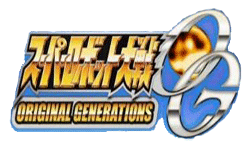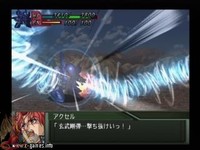|
|

|
PLATFORM
|
PS2
|
BATTLE SYSTEM
|

|
INTERACTION
|

|
ORIGINALITY
|

|
STORY
|

|
MUSIC & SOUND
|

|
VISUALS
|

|
CHALLENGE
|
Hard
|
COMPLETION TIME
|
More than 80 Hours
|
|
OVERALL

|
+ Two excellent games in one enormous package
+ Deep, engrossing tactical action throughout
+ Twin unit system interesting and useful
+ Music is varied and always captivating
- Original Generation 2.5 is repeated in Gaiden
- Might be hard for newcomers to grasp through the language barrier
|
Click here for scoring definitions
|
|
|
Super Robot Taisen: Original Generation and Original Generation 2 were released outside of Japan by Atlus in the twilight of the Game Boy Advance. Precisely why the remade PlayStation 2 versions of the games did not see release outside of Japan will likely never be known, but a surfeit of quality is most definitely not the reason. Banpresto remade two excellent games into one enormous package that will earn the everlasting gratitude of all tactical gamers looking for a rewarding title, and any PS2 owner with a tactical yen and an importing bug should investigate Super Robot Taisen: Original Generations ASAP.
In terms of story, Original Generations doesn't deviate much from the templates of its GBA forbears. Original Generation 1 deals with the efforts of Bian Zoldark to forcibly make Earth ready for war against an extraterrestrial threat by forming the Divine Crusaders, and the subsequent attacking of the Aerogators. Original Generation 2 involves disgruntled remnants of the Divine Crusaders seeking to steer the planet back towards Bian's goals, the intercession of more extraterrestrial menaces that are called the Inspectors and the Einst, and a faction from an alternate Earth reality called the Shadow Mirrors. The Shadow Mirrors' world is given additional background via some new missions in Original Generation 2, and a couple of new opponents are introduced who will play a role in Original Generation Gaiden. The character interactions are fun to watch, and the plot as a whole is rarely dull, but the lack of English will make this rather impenetrable to any who did not experience the Atlus USA localizations on the GBA. Fortunately, skipping through the plot rapidly can be done at any time, should the plentiful kanji discomfort anyone.
Super Robot Taisen combat resembles other tactical games such as Fire Emblem or Shining Force, at least superficially. The player takes a turn moving units around, then the enemy side gets its chance to attack. On defense, characters can counterattack with any weapon that has the proper range, concentrate on evasion and double the dodge rate, or concentrate on defense to halve the damage taken should an attack land. Unlike Fire Emblem, the random number generator is not fixed in Super Robot Taisen, allowing the patient to keep reloading in search of a favorable outcome. Characters earn experience from attacking enemies and money from taking them down, with money entering a pool that can be used as the player sees fit.
The amount of customization possible in Super Robot Taisen helps to distinguish its combat from other tactical games. Pilots possess innate abilities and can be switched between units until a good match is found, except for a few characters who have such an affinity with their starting robot that swapping can't be done. Pilot abilities come in two variants: the spirit commands that are learned by gaining levels and function like magic spells, and skills that are partly innate and partly customizable. The purpose of skills is incredibly varied: one increases the damage dealt when counterattacking, another regenerates ten spirit points every turn, and another increases both the attack power and range of non-melee weapons used by that character. Most of the starting character skills can be overwritten if something else looks better, allowing the team to be set up however one wants, though the pilot points necessary to obtain skills take awhile to accumulate and throwing them away by undoing earlier acquisitions is unwise.
 Keen eyes will notice that Axel is not the enemy, though only for one battle.
Keen eyes will notice that Axel is not the enemy, though only for one battle.
|
|
A pilot's innate abilities should mesh well with his or her chosen robot, and the robots can be tinkered with also. The money obtained via enemy destruction can be used either to increase a robot's statistics, or to increase the attack power of any weapon. Super robots cannot alter their innate weaponry, but Real robots have free pick of the many unfixed weapons that are acquired through the games. Tinkering with the many units and pilots available is freely encouraged, and the menu system is almost identical to that used in the GBA games, making it easy for veterans to adapt.
New to Original Generations is the Twin system, whereby units can unite into a Twin that takes up one space on the screen and initiates a double attack. To balance this somewhat, the attacks of the character not in the Twin unit's lead are weakened, though increased evasion and defense are granted by taking the supporting position. Both characters get experience and pilot points when in a Twin unit, though the lead gets a bit more. Enemies will begin to use the Twin system as well, which makes another change necessary. Most weapons will only target the lead unit of a Twin, but some will hit both, with the caveat that only another weapon hitting all targets can simultaneously attack, meaning that sometimes one member will have to sit an encounter out. The player always has the choice between which weapon will be used, keeping this system fair and fascinating. Another aspect of the Twin system comes from its granting a seventh Spirit command to characters, spells that are often very helpful and worth trying out.
 Oh no, Aerogators! Even a battleship can blow them all away with ease.
Oh no, Aerogators! Even a battleship can blow them all away with ease.
|
|
An ammunition augmentation system is also new to Original Generations, in which items are often dropped by enemies that can be used during intermission to alter the characteristics of certain weapons. Guns and other projectile munitions that can be interchanged are the recipients of these augments, which are usually a balance of good and bad. Some of them increase a weapon's range while decreasing its attack power, or increase its critical attack rate while lowering its accuracy. This system is a little harder to figure out through the Japanese language barrier, but the rewards for experimenting are potentially quite useful.
One other change has to do the Battle Mastery system. These are objectives separate from simply completing battles, and getting them often increases the difficulty noticeably. On the PS2 getting each Battle Mastery also grants five extra pilot points to every participating character, an enormous incentive to obtain them that makes skill acquisition considerably easier, and consequently makes upgrading pilots a faster process.
Original Generation 1 and Original Generation 2 are huge games, requiring scores of hours to complete. Original Generations not only has all the missions of the two GBA games (minus one at the end of OG 2 but with eight more), it has a remarkably effective lure for the then-upcoming Original Generation Gaiden in the form of Original Generation 2.5, containing a dozen extra missions that would be seen subsequently in that game. Completing everything in this game will take well over one hundred and twenty hours, with the usual incentives for replay being present also. A large sum of money and pilot points is carried over upon starting a completed save file, extra difficulty levels are unlocked, the alternate paths present in both games can be fully explored, and several hidden weapons and robots can be located, allowing hundreds of hours to be spent with the game after completing it.
 Raul sits out a long stretch when he's in some interdimensional warp, but he's pretty useful once out of there.
Raul sits out a long stretch when he's in some interdimensional warp, but he's pretty useful once out of there.
|
|
On an absolute scale, Super Robot Taisen: Original Generations is rather challenging. Some missions, particularly in 2, are quite tricky and depend on characters who have not been given the chance to upgrade surviving. Getting a Game Over is never the end, however, for the option exists to simply retry a battle while retaining the money and experience gained. Doing this makes obtaining the Battle Mastery impossible, but is much better than simply being forced to reload the last save. The Twin system makes many missions in the game easier than their GBA counterparts, also. Newcomers to the series will still have a rough time, but the game is never unmanageable in its difficulty.
Outside of combat animations, the visuals in Original Generations have certainly been upgraded over their GBA equivalents, but still do nothing to push the PS2. The combat animation is where the lion's share of visual effort went, and it shows in varied, well-animated, explosive attacks being launched by all participants. Every weapon looks just a little bit different, and the elaborate animations are quite entertaining. If ever the flow of battle is too disrupted by them, combat animation can be turned off with the touch of a button at any time to speed events along.
Banpresto could have simply given the music from the GBA Original Generation games upgraded PS2 arrangements and had a top-quality soundtrack, but numerous new compositions have been included in Original Generations, for the benefit of all listeners. Old favorites such as "Ash to Ash," "Trombe!," "Ice Man," and "Fairy Dancing" are joined by new ones including "Rushing Dandy," "Treue," and "Wild Flug." The resulting soundtrack is consistently excellent, with no bad spots to bog it down. Almost all of the voice acting occurs when battle animations play, and is of a generally high quality, though it can be hard to hear over the sound effects or when a Twin unit is simultaneously attacking. Being in Japanese with frequent English attempts for technical jargon, it may not mean much to those who do not speak the language anyway.
Super Robot Taisen: Original Generations could be faulted for dangling Original Generation 2.5 when Original Generation Gaiden would reprise that content almost verbatim, but cracking down on Banpresto for including even more content than the two GBA Original Generation games seems unfair. Tactical gamers unafraid of importing have no reason not to seek this game out; quality oozes from every portion. Captivating and challenging battles that are never finished with a simple Game Over is just the beginning of this game, with a plethora of content that few games can match inviting scores of hours to be spent exploring. Super may be part of the title, but this game manages to deserve the adjective.
Review Archives
|









